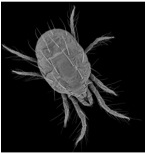
SEM image of the two-spotted spider mite T. urticae.
(Image by StephaneRombauts and WannesDermauw, Ghent University, Belgium)
The tiny two-spotted spider mite extracts nutrients from the leaves of 1,100 plant species including bioenergy feedstock crops. The global cost of chemically controlling this pest is estimated to be around $1 billion annually.
Given its potential to significantly reduce crop yields and inhibit biofuel production, the spider mite Tetranychusurticaewas selected for the 2007 DOE JGI Community Sequencing Program portfolio. Its 90-million base genome is now being used by an international team of researchers to develop pest control strategies that would reduce chemical dependence and environmental pollution. A report on how the genomic resources on the spider mite are being used appeared in the November 24, 2011 issue of Nature.
“Many aspects of the biology of the spider mite seem to facilitate rapid evolution of pesticide resistance,” said study senior author and DOE JGI collaborator Yves Van de Peer of the Flemish Institute for Biotechnology (VIB) and Ghent University, Belgium. “Control of these mites has become increasingly difficult and the genetic basis of such resistance remains poorly understood.”
DOE JGI Plant Program head Jeremy Schmutz, a co-author on the study, said that the genome showed microbial and fungal genes, supporting the theory of lateral gene transfer as a mechanism for plant pathogens to more efficiently extract nutrients from crops.He added that the genomic data is also useful in better understanding plant-pathogen interactions. “Most of the genomic work has been done with molds and fungal pathogens, but insects are a major issue for biofuel crops.”